Unknown Manufacturer
Hein Photographic Supply Co. (New York), distributor
Counterfeit American Optical Co. Landscape Reversible View
This is an engraving of the AO Landscape
Reversible View of which the camera below is a copy (American Annual of Photography and
Photographic Times Almanac for 1899,
p. 60)
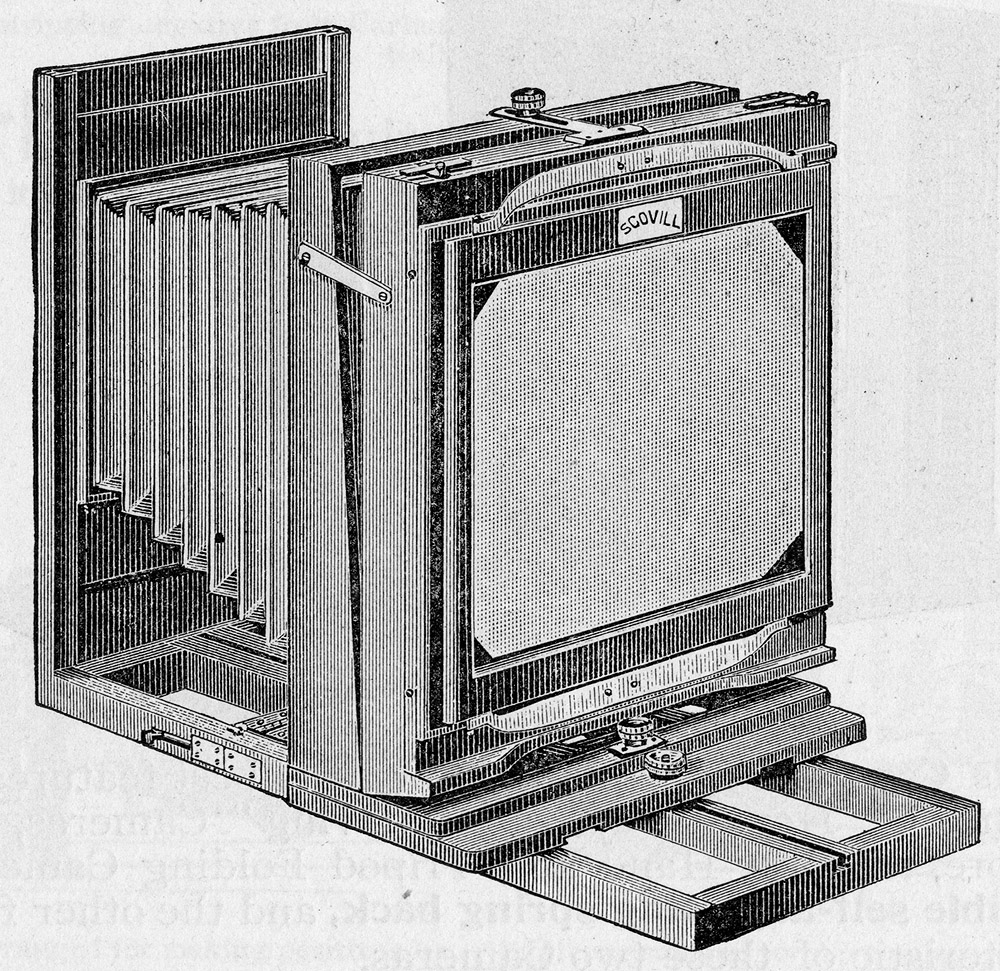
8 x 10" Bottomm Topp Celluloid Label - upper portion
of the ground glass frame: "Hein Photographic Supply Co., 197 Grand
Street, New York.""
Identifying a CounterfeitIdentifying a Counterfeit
(Comparison Photos Below)
Lower Side Views (above):
Upper Back Views (above):
Manufacturer:
Unknown This camera is a very good
reproduction of the design of the
American Optical Landscape Reversible View
Variation 1.
Having said that, it can be seen that almost every detail of the camera
is different than the corresponding part of an AO camera. Some
examples are shown above, under Identifying a Counterfeit.
Landscape Reversible View Camera Model -
Variations:
To second-guess the
Scovill & Adams
executives, the
Flammang's
Patent Revolving Back Camera
would appear to be a very expensive camera to be the only offering of
this type. Remember that a rear-focus camera is the only viable
option for very large (usually professional) cameras, while the cone
bellows reduces the weight of the very same large cameras. It is
as if
Scovill & Adams
was abandoning or at least reducing the options
for the professional photographer. Whatever the reason for
discontinuing the
Acme, it
would seem that the executives soon recognized that a camera of lower
cost than that of the
Flammang's
was needed - by the 1896 catalog, the
Flammang's Revolving Back cameras have disappeared and the
Landscape Reversible Back Camera has appeared.
One
major design difference between the
Landscape Reversible View and the
Acme Reversible View
and the
Flammang's Revolving Back View is that it has a
simple, two spring, spring back arrangement - a design based on Thomas
Blair's Sep. 2, 1884 patent, used on cameras of almost all plate or film
view cameras made after 1901 (around the time the patent expired), and
still used today. Ads for the
Landscape Camera always show the
thinner and modern style (~ ½" thick) removable and reversible back,
just as
Acme
ads always show their thick (more than 1" thick) back. A second new feature
is a thick, all-wood construction front standard; the rising panel fits
into vertical slots in the standard sides. The rising panel is
quite recessed behind the surface of the front standard, whereas the
Acme
and
Flammang's Revolving Back
rise panels are even with the supporting sides of the
standard. The
rise locking mechanism is a spring-loaded button on the upper right side
of the front standard, which, when pushed, disengages a saw-tooth shaped
strip of steel.. In the older
Acme
and
Flammang's Revolving Back
cameras, the rising panels fit into slots in the standard sides, but
panel is held in by full-height brass strips; the rising panel is
controlled via a thumbscrew.
Landscape
Reversible View Camera Variation 1: This variation
has a push-pull focus locked with a thumbscrew in the middle of the base
of the rear standard. Its vertical swing is push-pull, hinged at
the bottom of the rear standard and controlled/locked by a slotted plate
and thumbscrew on the top middle of the rear standard. Its
horizontal swing is push-pull, locked by a thumbscrew just in front of
the focus-locking thumbscrew. The folding platform is made rigid
using the familiar Flammang's patent rod and cylinder device used on so
many Scovill
products. The hardware is polished and lacquered brass. Another camera of interest to Landscape Camera design:
Landscape
Reversible View Camera
Variation 2:
This variation, while retaining the same essential design as
Variation
1, has quite a number of
differences: 1)the focus is rack and pinion rather than push-pull;
2) the vertical swing is hinged at the bottom, but controlled/locked by
a slotted plate and thumbscrew on the lower right side of the rear
standard (very similar to a number of
Scovill
products, the most common of which is the
Scovill Waterbury View Variation 2);
3)the example has no horizontal swing, 4) the folding platform is
made rigid with a simple thumbscrew and threaded plate rather than the
patented rod and cylinder device (amazing), and 5) the hardware is
nickel-plated rather than lacquered brass.
References:
Back to American Optical
Co. / Scovill Mfg. Co. (alphabetical)
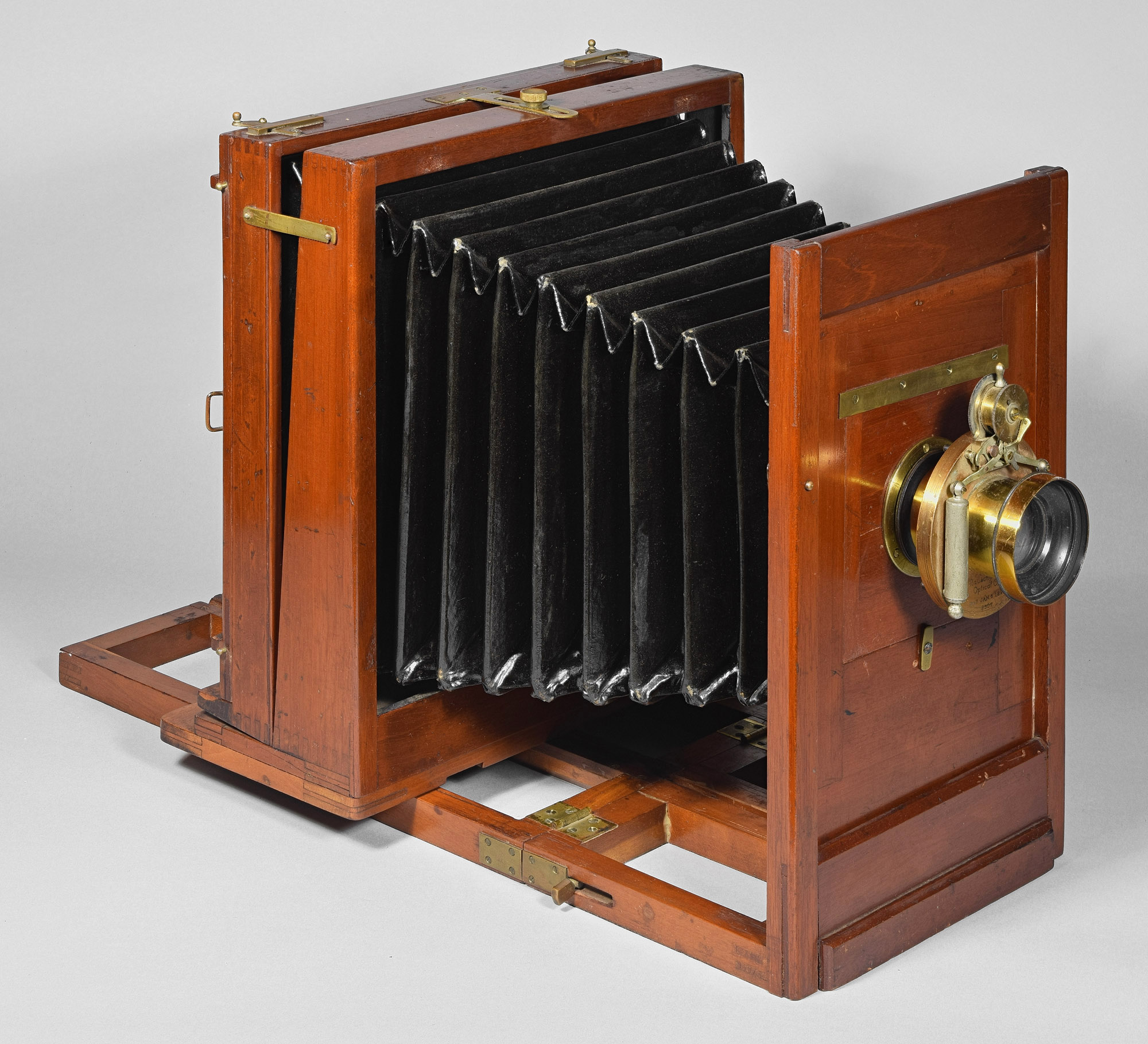

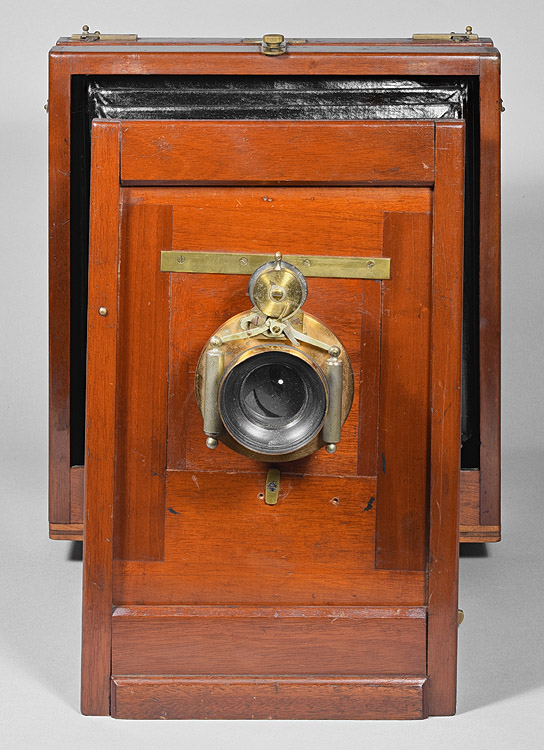
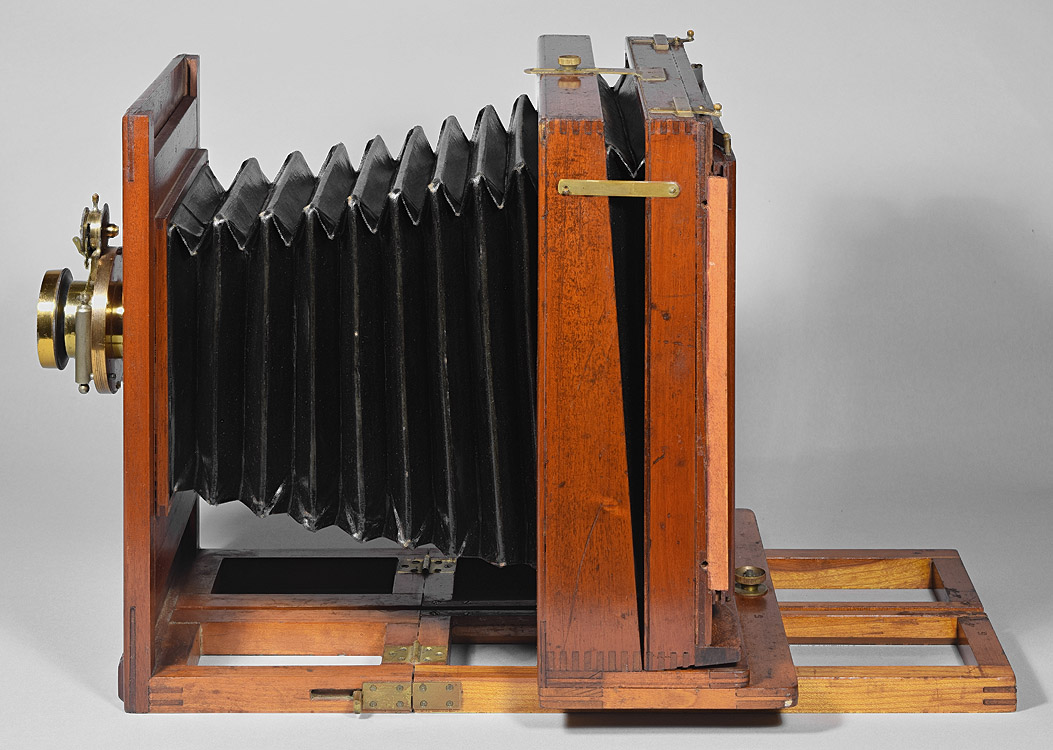
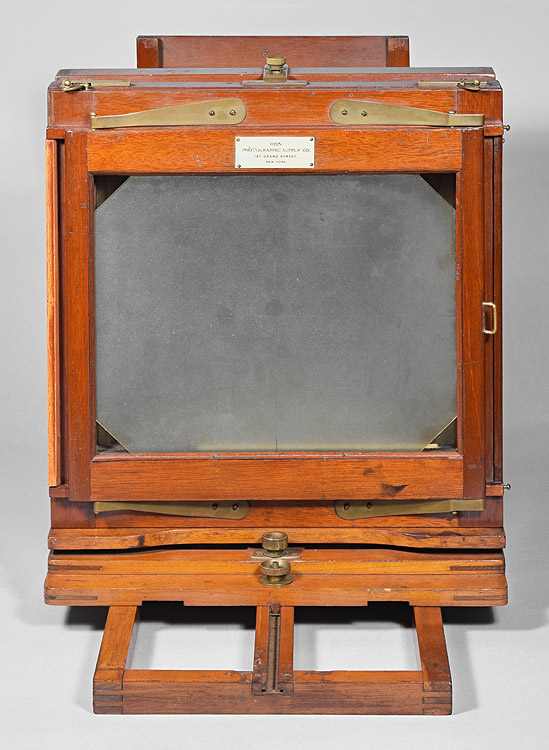
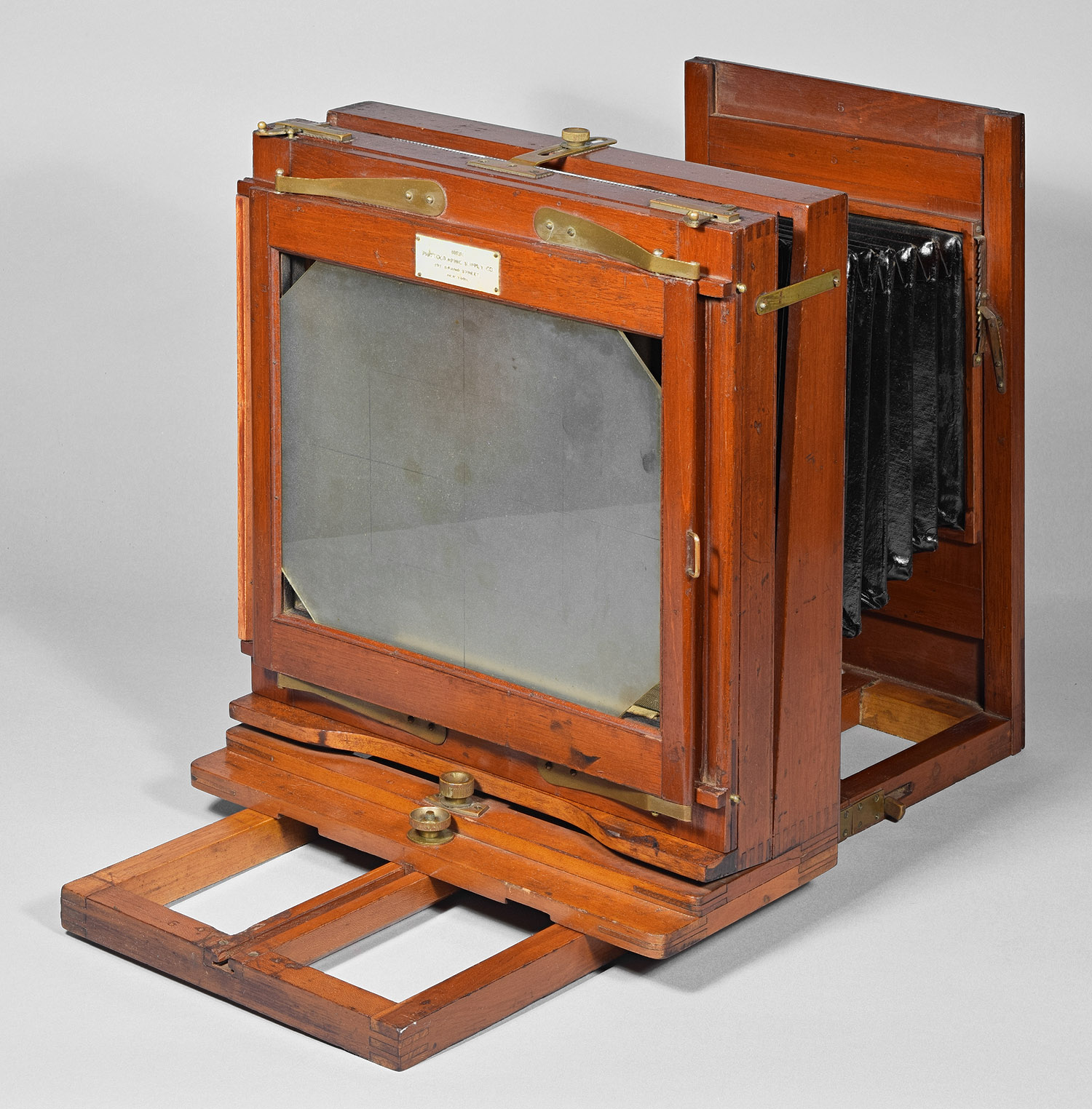
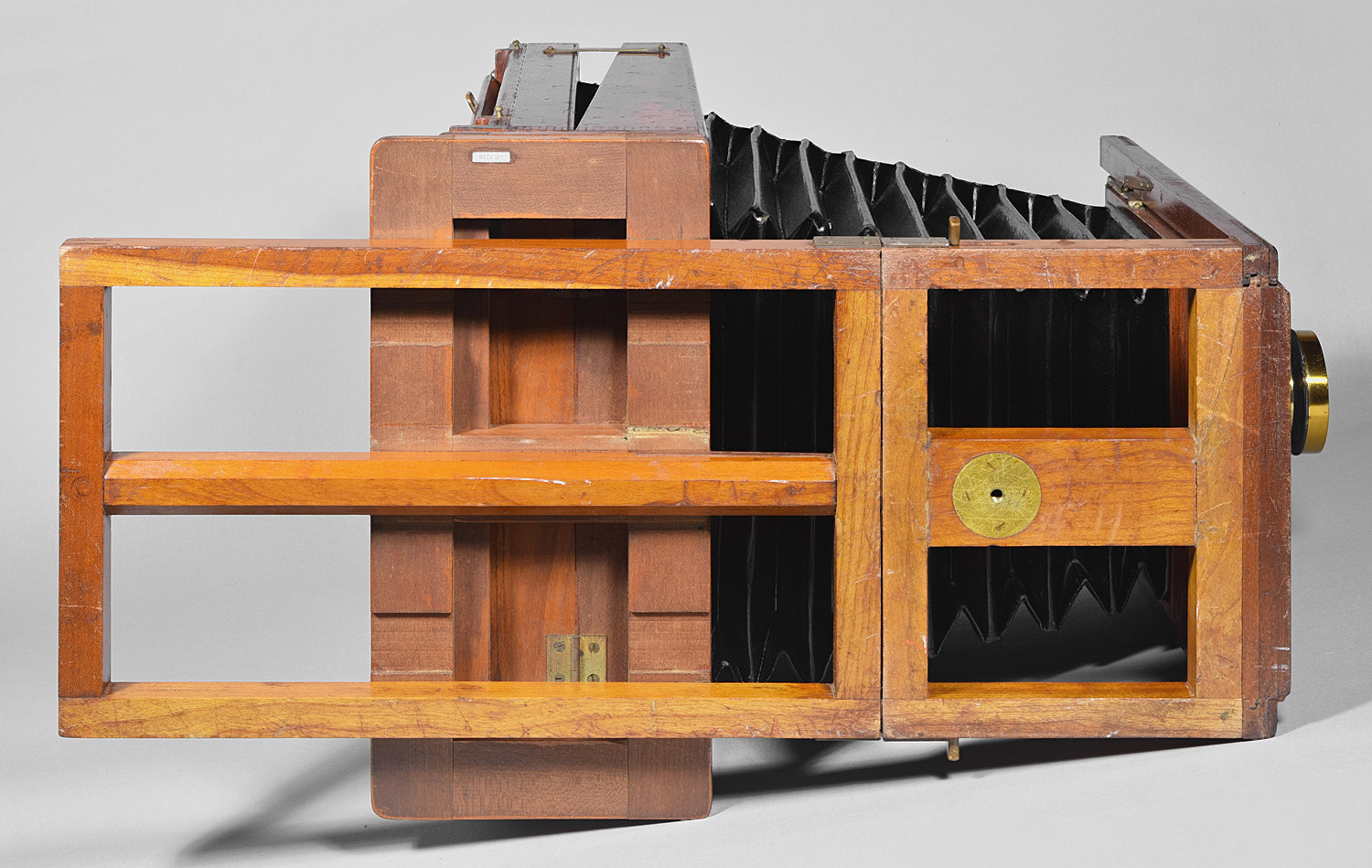
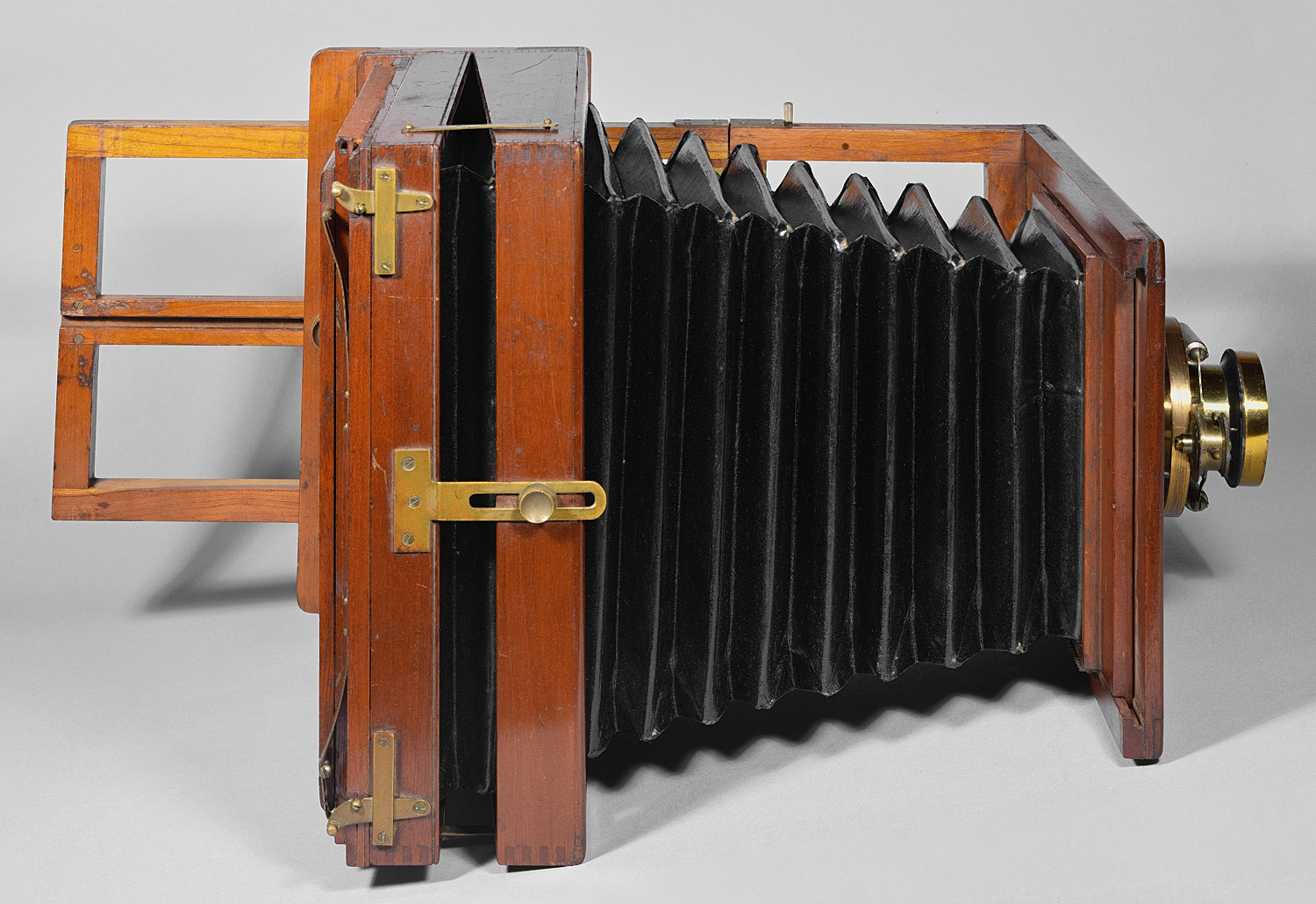
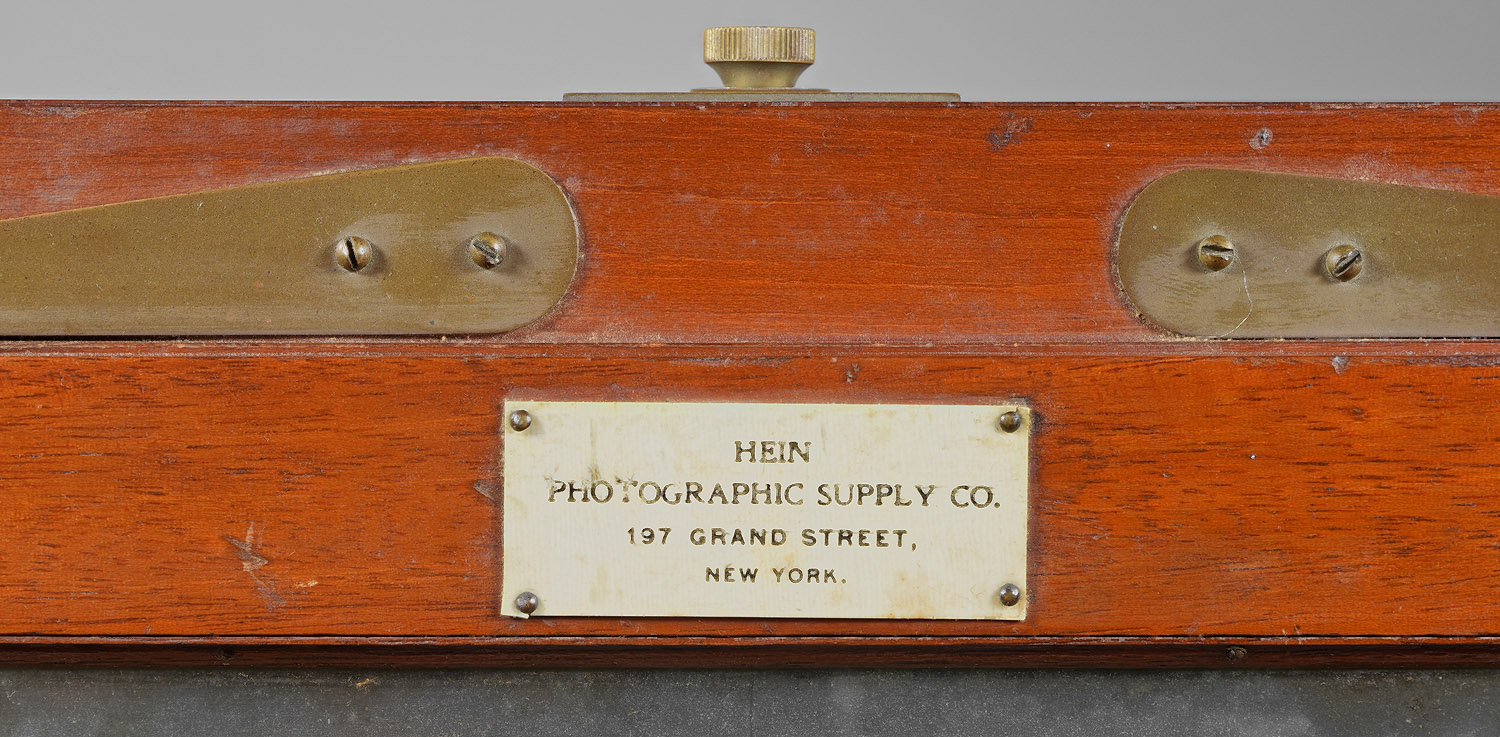
Below are side-by-side photos
of an authentic American Optical Landscape
Reversible View and the
Counterfeit Landscape Reversible View. Differences
between the cameras are numbered on each photo, and described below the
photos.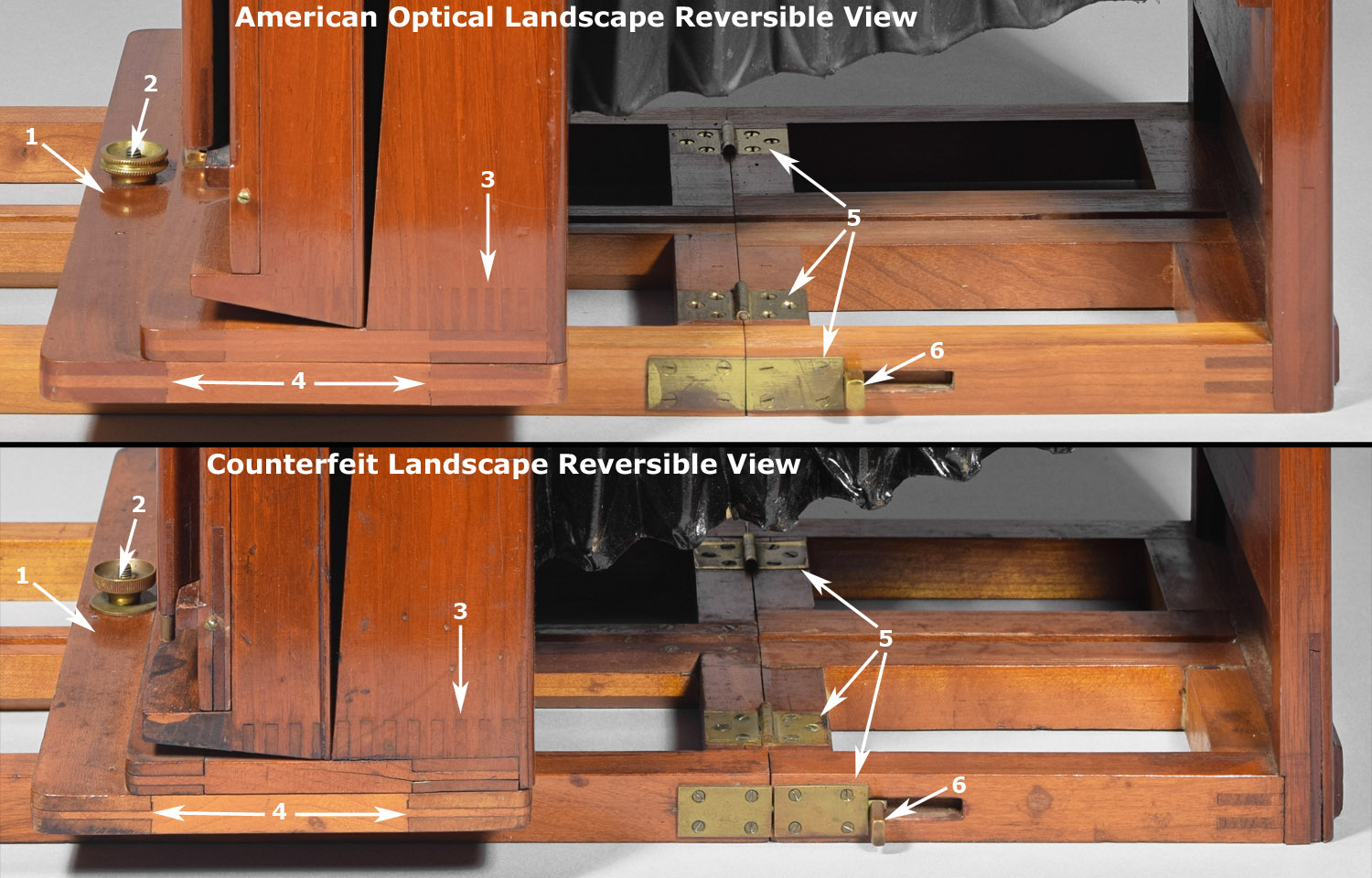
1) The American Optical wood has been
finished using the French polish method, and is much smoother and
shinier than the counterfeit, which has one coat of varnish.
2) The thumbscrews have a different profile/shape.
3) The AO rear standard box joint being pointed at had eleven tabs,
whereas the counterfeit has eight.
4) The AO joint at the bottom of the rear standard has equally-sized
tabs, whereas the counterfeit has a thin tab between thicker ones.
5) As usual with AO products, the screws have been laboriously chosen to
make all their slots parallel, then they are perfectly flattened by
draw-filing, whereas the counterfeit screws were randomly chosen and not
filed to flatness.
6) The AO handle for the Flammang patent rod and piston catch is thicker
than the counterfeit version. That the AO camera does not have a
stamp proclaiming the patent date must mean that the patent had expired.
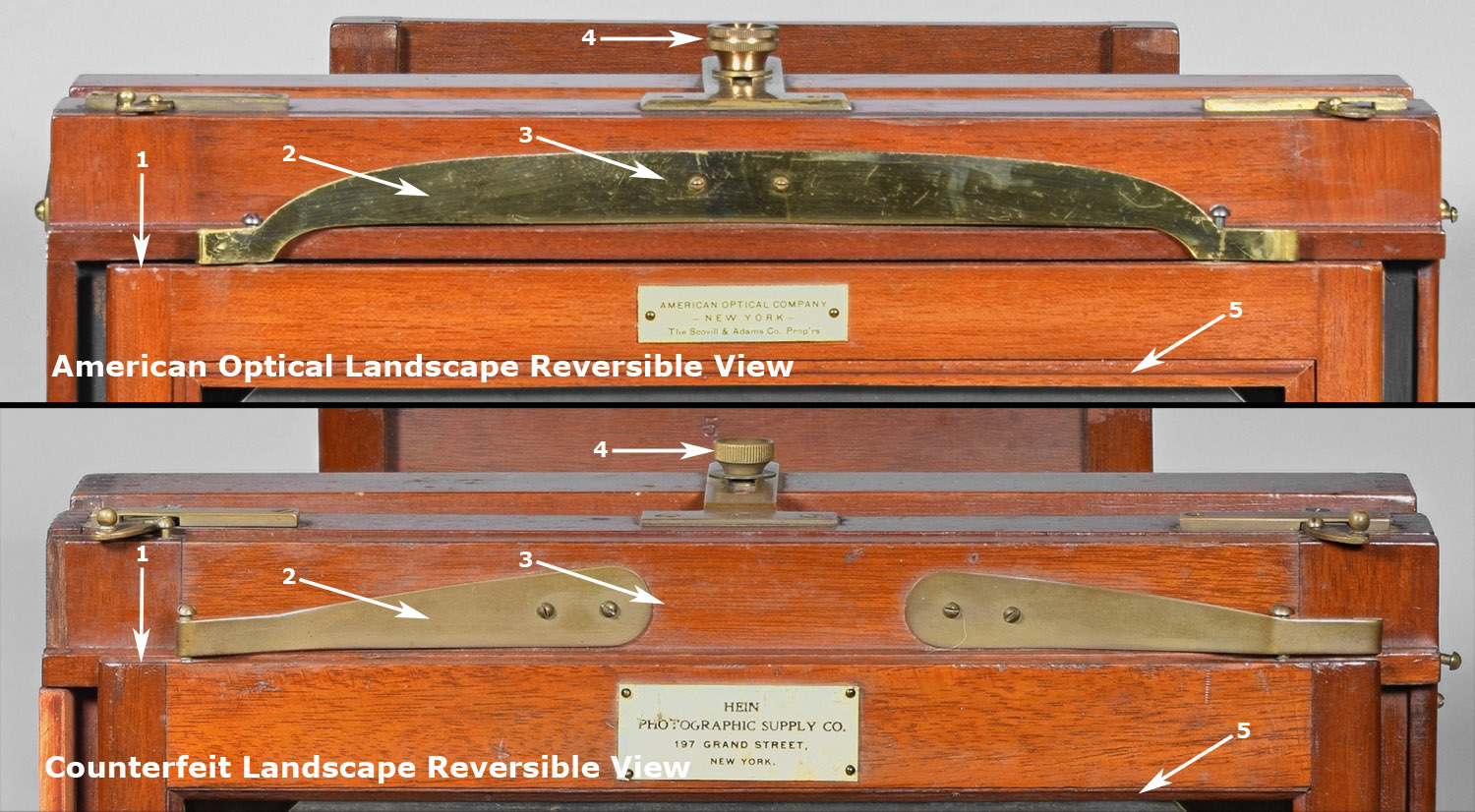
1) The ground glass frame of the AO
camera fits within a recess. The counterfeit has such a recess,
but the ground glass frame sits on top of the top edge of the recess.
2) The AO brass hardware is polished and lacquered, whereas the
counterfeit has not been polished and is bare brass that now has a matt
luster.
3) The AO spring back has two long springs (one along the top and
another along the bottom). The counterfeit uses four short
springs. This is the most obvious difference between the cameras.
4) The AO thumbscrew has a different profile/shape than the counterfeit
has.
5) Both cameras secure the ground glass using thin wooden trim that is
nailed to the frame, but the width and shape of the trim is different.
Date Introduced: ;
Years Manufactured: c.1899
Construction: rear
focus via push-pull; single swing,
reversing by removable back; three-piece lens board
Materials: mahogany body; cherry base;
black fabric bellows; brass hardware
Sizes Offered: at least 8x10
Notes: 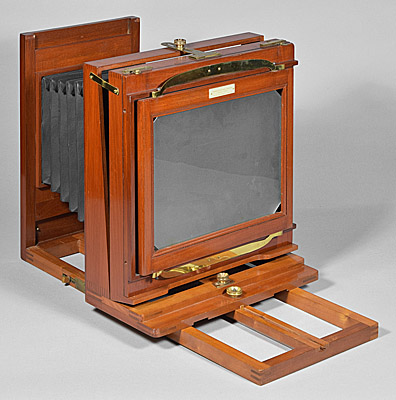 The
Acme and the
Landscape cameras were never advertised at the same time.
In fact there is a gap of at least two years between the apparent
abandonment of the
Acme and
the start of the
Landscape.
Neither the Acme nor the
Landscape view cameras were
advertised in the Scovill & Adams
Co. catalogs for
January 1889,
March 1889,
March 1890,
June 1890,
April 1891,
June 1891, and
January 1892 (but no examples of catalogs from late 1892 through
early 1895 have been observed as yet) or in the almanacs for 1892, 1893,
1894 and 1895. However, it is also entirely possible that
Acme-type
cameras were still being manufactured 1892-1894, despite the lack of
advertising seen so far. During this
Acme-Landscape
gap, the only rear focus, cone bellows view camera advertised was the
Flammang's Patent
Revolving Back Camera Back Focus (a camera that is,
other than its revolving back, identical to the
Acme).
The
Acme and the
Landscape cameras were never advertised at the same time.
In fact there is a gap of at least two years between the apparent
abandonment of the
Acme and
the start of the
Landscape.
Neither the Acme nor the
Landscape view cameras were
advertised in the Scovill & Adams
Co. catalogs for
January 1889,
March 1889,
March 1890,
June 1890,
April 1891,
June 1891, and
January 1892 (but no examples of catalogs from late 1892 through
early 1895 have been observed as yet) or in the almanacs for 1892, 1893,
1894 and 1895. However, it is also entirely possible that
Acme-type
cameras were still being manufactured 1892-1894, despite the lack of
advertising seen so far. During this
Acme-Landscape
gap, the only rear focus, cone bellows view camera advertised was the
Flammang's Patent
Revolving Back Camera Back Focus (a camera that is,
other than its revolving back, identical to the
Acme).
Counterfeit Landscape
Reversible View Camera Variation 1:
This camera is a very good
reproduction of the design of the
American Optical Landscape Reversible View Variation 1.
Having said that, it can be seen that almost every detail of the camera
is different than the corresponding part of an AO camera. Some
examples are shown above, under Identifying a Counterfeit.
